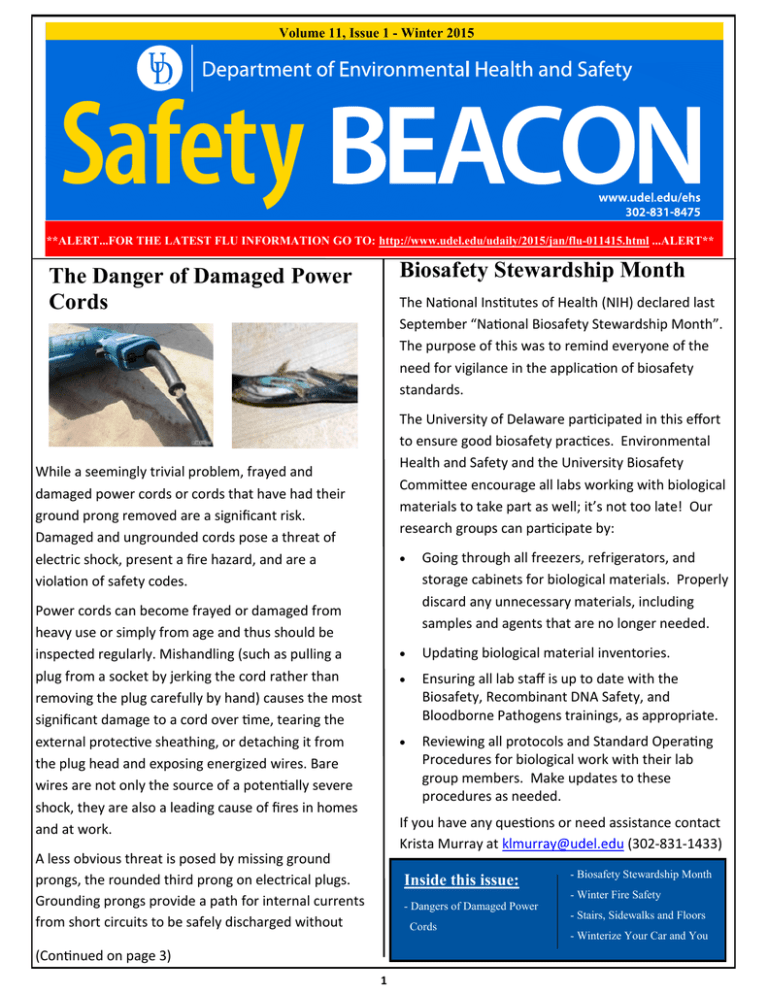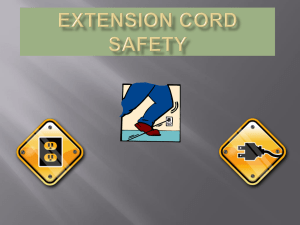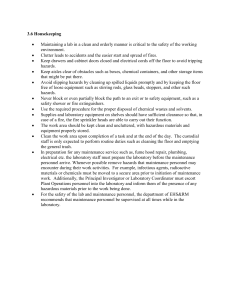Biosafety Stewardship Month The Danger of Damaged Power Cords
advertisement

Volume 11, Issue 1 - Winter 2015 **ALERT...FOR THE LATEST FLU INFORMATION GO TO: http://www.udel.edu/udaily/2015/jan/flu-011415.html ...ALERT** Biosafety Stewardship Month The Danger of Damaged Power Cords The National Institutes of Health (NIH) declared last September “National Biosafety Stewardship Month”. The purpose of this was to remind everyone of the need for vigilance in the application of biosafety standards. The University of Delaware participated in this effort to ensure good biosafety practices. Environmental Health and Safety and the University Biosafety Committee encourage all labs working with biological materials to take part as well; it’s not too late! Our research groups can participate by: While a seemingly trivial problem, frayed and damaged power cords or cords that have had their ground prong removed are a significant risk. Damaged and ungrounded cords pose a threat of electric shock, present a fire hazard, and are a violation of safety codes. Power cords can become frayed or damaged from heavy use or simply from age and thus should be inspected regularly. Mishandling (such as pulling a plug from a socket by jerking the cord rather than removing the plug carefully by hand) causes the most significant damage to a cord over time, tearing the external protective sheathing, or detaching it from the plug head and exposing energized wires. Bare wires are not only the source of a potentially severe shock, they are also a leading cause of fires in homes and at work. Going through all freezers, refrigerators, and storage cabinets for biological materials. Properly discard any unnecessary materials, including samples and agents that are no longer needed. Updating biological material inventories. Ensuring all lab staff is up to date with the Biosafety, Recombinant DNA Safety, and Bloodborne Pathogens trainings, as appropriate. Reviewing all protocols and Standard Operating Procedures for biological work with their lab group members. Make updates to these procedures as needed. If you have any questions or need assistance contact Krista Murray at klmurray@udel.edu (302-831-1433) A less obvious threat is posed by missing ground prongs, the rounded third prong on electrical plugs. Grounding prongs provide a path for internal currents from short circuits to be safely discharged without Inside this issue: - Dangers of Damaged Power Cords (Continued on page 3) 1 - Biosafety Stewardship Month - Winter Fire Safety - Stairs, Sidewalks and Floors - Winterize Your Car and You Safety Beacon Department of Environmental Health and Safety - Volume 11, Issue 1 - Winter 2015 As another arctic winter sneaks up on us and forces us to take most of our activities indoors, the number of residential structure fires increases. According to the United States Fire Administration’s National Fire Incident Reporting System, winter residential building fires account for approximately 945 deaths, 3,825 injuries, and $1,708,000,000 in property loss each year. While cooking remains the leading cause of fires throughout the year, colder months bring fires caused by seasonal items such as electrical heaters, fireplaces, and candles. Decorating your home is a long-standing tradition around the holiday season. Unfortunately, some of these decorations can also increase your chances of fire. Data from the National Fire Protection Association and the United States Fire Administration shows that an estimated 240 home fires involve Christmas trees and another 150 home fires involve holiday lights and other decorative lighting each year. According to the NFPA these fires have caused an average of 6 deaths, 22 injuries and $18.3 million in property damage in the last seven years. To help ensure that you have a fire-safe winter and holiday season, you can follow some simple fire safety tips: Heating Your Home Never use a range or an oven as a supplemental heat source. Not only is it a fire hazard, it can also be a source of toxic fumes such as carbon monoxide. If you use an electric heater, be sure not to overload the circuit. Only use extension cords that are the same size or larger than the appliance’s electrical cord. If you use a fireplace do not use flammable liquids to start or accelerate the fire. Keep a glass or metal screen in front of the fireplace opening to prevent embers or sparks from jumping out. Also keep flammable materials away from the fireplace and mantel; a spark from the fireplace can easily ignite these materials. Make sure that your fireplace/fire is out before you go to sleep and NEVER close your damper with hot ashes in the fireplace. Finally, have your chimney inspected annually and cleaned if necessary. Candles Make sure that candles are in stable holders and keep them where they cannot tip over easily. Try to keep them at least 12 inches from anything that can burn. Consider using battery-operated flameless candles, which can look and smell like real candles. NEVER leave a lit candle unattended, and NEVER put lit candles on a Christmas tree. Following these simple tips can keep you, your family, and your guests safe. As in every season, be sure to have working smoke alarms installed on every level of your home. Test them monthly and replace the batteries twice a year (and when needed). Know when and how to call for help, and remember to discuss and practice your home escape plan with your loved ones. 2 Safety Beacon Department of Environmental Health and Safety - Volume 11, Issue 1 - Winter 2015 The Danger of Damaged Power Cords (continued from page 1) harming the user or equipment. These ground prongs often break off from mishandling or are removed intentionally to fit a plug into two-prong outlets. Ungrounded plugs can pose a risk of electrocution should the device experience an internal short. If your device has three prongs and you need to plug into a two-prong outlet, DO NOT use a three-prong adaptor; instead contact your building manager to arrange for the installation of a properly grounded outlet. The use of three-prong adaptors are not permitted at the University as they are potentially dangerous; for example, in August 2005 an associate professor at Cleveland State University was electrocuted when he plugged a defective fluorescent lamp into an outlet using a three-prong adaptor. EHS recommends that labs and classrooms regularly inspect all power cords and remove any cords that show signs of wear before they become damaged. Most cords can be replaced easily by qualified electricians. EHS also recommends that everyone practice good sense when using power cords: resist the temptation to pull on the cord to disconnect equipment from outlets, only pull on the plug and keep power cords out of aisles and walkways where they might be crushed by personnel or equipment. Stairs, Sidewalks, and Floors According to the National Safety Council, falling while walking on flat surfaces or while going up and down stairs is one of the leading causes of accidental injuries in the United States, accounting for over 8.9 million visits to the emergency room annually. Injuries from falls can range from bumps and bruises to sprains, fractures and potentially serious head injuries. A few moments of thought go a long way to preventing these falls. While using stairs and steps: Keep at least one hand free and use handrails if they are available. Should you miss a step or slip, a firm grip on a handrail can prevent a serious tumble. Watch for wet surfaces, cracks, or other damage to the steps. Report these problems to x1141 so someone else doesn’t fall victim If there is room, keep to the right to avoid striking someone coming in the opposite direction. When walking on flat surfaces: Be aware of the surface you on which you are walking. Cracks, raised or sunken pavers, ice, wet leaves, and newly scrubbed floors are among the many things that could cause you to lose balance due a moment’s inattention. Report problems to x1141. (continued on page 4) 3 Safety Beacon Department of Environmental Health and Safety - Volume 11, Issue 1 - Winter 2015 Stairs, Sidewalks, and floors (continued from page 3…) Walking “off road” can be especially dangerous. Grass, snow, and leaves can cover holes in the ground or disguise sudden dips and rises. Stick to well-maintained paths if at all possible; a short cut won’t save any time if you fall and hurt yourself. Similarly, when snow and ice are on the ground, avoid areas that have not been cleared and treated. Remember that surfaces that just look damp may actually be covered with black ice. Be careful stepping off or onto curbs- a slight miscalculation of the difference in heights can cause a tumble. No matter where you are walking or what the surface is, do not text and walk. Just as you shouldn’t text and drive, keep the messaging until you are not moving- you need both eyes free to look where you are going. Winterize Your Car and You An emergency situation on the road can arise at any time and you must be prepared. Following the tune-up, a full tank of gas, and fresh anti-freeze, your trunk should carry: • A properly inflated spare tire, wheel wrench and tripod-type jack • A shovel • Jumper cables • Tow and tire chains • A bag of salt or cat litter •Tool kit Be prepared with a "survival kit" that should always remain in the car. Replenish after use. Essential supplies include: •Working flashlight and extra batteries •Reflective triangles or brightly-colored cloth •First aid kit •Exterior windshield cleaner •Ice scraper and snow brush If you become stranded, do not leave your car unless you know exactly where you are, how far it is to possible help, and are certain you will improve your situation. To attract attention, light two flares and place one at each end of the car a safe distance away. Hang a brightly colored cloth from your antenna. If you are sure the car's exhaust pipe is not blocked, run the engine and heater for about 10 minutes every hour or so depending upon the amount of gas in the tank. To protect yourself from frostbite and hypothermia, use woolen items and blankets to keep warm. Keep at least one window open slightly as heavy snow and ice can seal a car shut. 4





